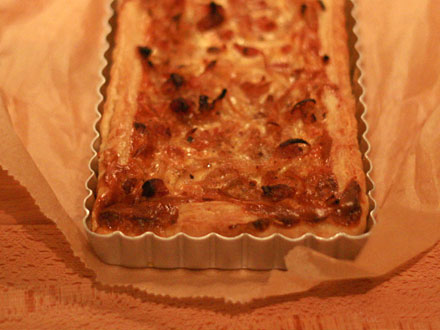Sweet braided yeast loaves have a long tradition for Easter Celebrations here in Germany. Or better said all over Europe ;)
I can understand why – it is pretty easy to make (takes some time, but the yeast is actually doing most of the work) and super delicious. And so versatile! You can make those loaves plain, with raisins or other fruits, nuts, poppy seed, chocolate… and then eat it for breakfast or with a coffee in the afternoon or just all day as a snack (that’s how I do it).

So one of those sweet braided loaves is definitely on the Easter Brunch Buffet in my house. This one here is made in a springform with a special bottom (bundt cake) – that makes it even easier, because you won’t have to worry about the shape – it will have the perfect shape – nothing can go wrong here. I did a pretty bad braiding job and was sloppy when transferring it to the form – but it turned out excellent ;)
INGREDIENTS / ZUTATEN
1.5 oz. fresh yeast
1 cup (250ml) lukewarm milk
1/4 cup (50g) sugar
4 cups (500g) all-purpose flour
1/3 cup (80g) butter, room temperature
pinch of salt
2 eggs
zest of 1 organic lemon
For the decoration:
1 egg yolk
1 tbsp. sugar
some milk
sugar crystals
1 Würfel (42g) frische Hefe
250ml lauwarme Milch
50g Zucker
500g Mehl (Type 405)
80g weiche Butter
1 Prise Salz
2 Eier
1 Bio-Zitrone, Abrieb
Für die Dekoration:
1 Eigelb
1 EL Zucker
etwas Milch
etwas Hagelzucker


DIRECTIONS / ZUBEREITUNG
2. Sift the flour into a large bowl. Add the remaining sugar, butter, salt, eggs, lemon zest and the yeast mixture – knead for about 10 minutes until you get a nice smooth dough. Cover with a kitchen towel and let rise for about 1 hour in a warm place.
3. Grease a 10 inches (26cm) bundt pan and set aside. Take the dough out of the bowl and knead once more on a floured surface. Cut into three pieces and form each piece of dough into a 20 inches (50cm) string. Braid the strings and transfer to the prepared bundt pan – try to braid the ends or tuck them in/underneath. Cover with a kitchen towel and let rise once more in a warm place for 1 hour.
4. Preheat the oven to 390˚F (200°C). Whisk the egg yolk with the sugar and milk until well combined. Brush the savarin with the mixture and sprinkle with sugar crystals. Bake in the oven for 15 minutes. Reduce the heat to 350˚F (175°C) and bake for another 20-25 minutes or until toothpick inserted in center comes out clean. The savarin should have a nice golden brown color. Take out of the oven and let cool in the form for some time. Remove carefully from the form and let coold down completely on a wire rack.
2. Mehl in eine große Schüssel sieben. Restlichen Zucker, Butter, Salz, Eier, Zitronenschale und Hefemilch zugeben und alles in etwa 10 Minuten zu einem glatten Teig verarbeiten. Mit einem Küchentuch abdecken und etwa 1 Stunde an einem warmen Ort gehen lassen.
3. Eine 26cm (10 inches) Springform mit Rohrboden einfetten und zur Seite stellen. Den Teig noch einmal auf einer bemehlten Arbeitsfläche durchkneten und dann in 3 Stücke Teilen. Jedes Teigstück zu einer etwa 50cm (50 inches) langen Rolle formen. Aus den Rollen einen Zopf flechten und in die vorbereitete Springform legen – die Enden zusammenflechten und nach unten schieben. Mit einem Küchentuch abdecken und an einem warmen Ort für eine weitere Stunde gehen lassen.
4. Den Ofen auf 200°C (390°F) vorheizen. Eigelb mit Zucker und etwas Milch verrühren und den Kranz damit bestreichen. Mit Hagelzucker bestreuen und im Ofen für 15 Minuten backen. Hefekranz im Ofen lassen, Hitze auf 175°C (350°F) reduzieren und für weitere 20-25 Minuten backen – mit einem Zahnstocher testen, ob noch Teig kleben bleibt und erst herausnehmen, wenn der Zahnstocher sauber herauskommt. Der Kranz sollte eine schöne goldbraune Farbe haben. Aus dem Ofen nehmen und in der Form etwas abkühlen lassen, vorsichtig lösen und dann auf einem Kuchengitter komplett auskühlen lassen.
Craving more? Keep in touch on Facebook, Twitter, Instagram and Pinterest for new post updates and more. You can also contact me with any questions or inquiries!
Here is a version of the recipe you can print easily.
Print
Hefekranz aka. Savarin
- Prep Time: 25
- Cook Time: 30
- Total Time: 150
Ingredients
For the dough
- 1.5 oz. (42g) fresh yeast
- 1 cup (250ml) lukewarm milk
- 1/4 cup (50g) sugar
- 4 cups (500g) all-purpose flour
- 1/3 cup (80g) butter, room temperature
- pinch of salt
- 2 eggs
- zest of 1 organic lemon
For the decoration
- 1 egg yolk
- 1 tbsp. sugar
- some milk
- sugar crystals
Instructions
- Crumble the yeast into a small bowl, add lukewarm milk and a teaspoon of the sugar and mix until the yeast has dissolved. Let rest in a warm place for 15 minutes.
- Sift the flour into a large bowl. Add the remaining sugar, butter, salt, eggs, lemon zest and the yeast mixture – knead for about 10 minutes until you get a nice smooth dough. Cover with a kitchen towel and let rise for about 1 hour in a warm place.
- Grease a 10 inches (26cm) bundt pan and set aside. Take the dough out of the bowl and knead once more on a floured surface. Cut into three pieces and form each piece of dough into a 20 inches (50cm) string. Braid the strings and transfer to the prepared bundt pan – try to braid the ends or tuck them in/underneath. Cover with a kitchen towel and let rise once more in a warm place for 1 hour.
- Preheat the oven to 390˚F (200°C). Whisk the egg yolk with the sugar and milk until well combined. Brush the savarin with the mixture and sprinkle with sugar crystals. Bake in the oven for 15 minutes. Reduce the heat to 350˚F (175°C) and bake for another 20-25 minutes or until toothpick inserted in center comes out clean. The savarin should have a nice golden brown color. Take out of the oven and let cool in the form for some time. Remove carefully from the form and let coold down completely on a wire rack.
Notes
- Happy Easter
Nutrition
- Serving Size: 16







 I love my job, but in between I love to bake and try new things in the kitchen. A lot of my friends and colleagues encourage me to bake - for a very simple reason: they get the leftovers - and it seems they like it most of the time ;)
I love my job, but in between I love to bake and try new things in the kitchen. A lot of my friends and colleagues encourage me to bake - for a very simple reason: they get the leftovers - and it seems they like it most of the time ;) 











